| Pages:
1
..
42
43
44
45
46
..
48 |
Arcuritech
Harmless

Posts: 34
Registered: 19-8-2012
Location: Scraping fused boria from a crucible.
Member Is Offline
|
|
What about metallic crystalline Boron? Silicon was mentioned in the first post, and that also might work. Fortunately for me I have both of these
things, I'll have to test them out next time I'm in my lab.
"If we knew what we were doing, it wouldn't be called research." -Albert Einstein
"There are few things -- whether in the outward world, or, to a certain depth, in the invisible sphere of thought -- few things hidden from the man
who devotes himself earnestly and unreservedly to the solution of a mystery." -Nathaniel Hawthorne ("Roger Chillingworth")
|
|
|
White Yeti
National Hazard
   
Posts: 816
Registered: 20-7-2011
Location: Asperger's spectrum
Member Is Offline
Mood: delocalized
|
|
What about using polythiazyl as an anode material? This has already been discussed in several small threads that I will not cite. But discussion has
died down very quickly, perhaps because of the dangers associated with making and handling S2Cl2. I would like to present a
different synthesis route for S4N4 (the precursor to polythiazyl) involving liquid ammonia and solid sulfur instead of
S2Cl2 and gaseous ammonia:
10S(s) + 4NH3(l) —→ N4S4(s)+ 6H2S(g)
Source:
Handbook of Inorganic Chemicals by Pradyot Patnaik
The S4N4 can then be reacted over silver metal to yield its polymer.
Does anyone have information on the electrical conductivity of this polymer and/or its chemical inertness?
"Ja, Kalzium, das ist alles!" -Otto Loewi
|
|
|
elementcollector1
International Hazard
    
Posts: 2684
Registered: 28-12-2011
Location: The Known Universe
Member Is Offline
Mood: Molten
|
|
I have something interesting to contribute, and I WILL share it with you!
While electrodepositing manganese metal from it's aqueous chloride, I noticed that if too much current is applied to the solution, or only one cell of
electrolysis is used, the cathode will receive a firm, strong deposit of MnO2, resistant to flaking and such. Chlorate anode? We'll see.
It wasn't exactly what I wanted at the time, but I thought it might be useful to you.
Elements Collected:52/87
Latest Acquired: Cl
Next in Line: Nd
|
|
|
offset442
Harmless

Posts: 8
Registered: 19-10-2012
Member Is Offline
Mood: No Mood
|
|
I have recently come to interest in this type of anode, and while exploring the "ironage" iron mine near twenty nine palms, ca. I now have some very
large massive chunks of hydrothermal generated natural magnitite, and a few small slabs of very well formed massive crystals hammered off a monolythic
rock the size of a car. I currently looking for someone that has a diamode saw with a feeder co I can cut some nice slabs, considering that I have an
unlimited source of this material it has not peaked my inteast, also iron mines are very common, I bet a lot of ppl live within reasonable distance
fro one to pluck chunk of out magnatite of a near by wash. Just an idea.
|
|
|
Swede
Hazard to Others
  
Posts: 491
Registered: 4-9-2008
Member Is Offline
Mood: No Mood
|
|
JPSmith, have you pursued the Bi Pyrochlore at all that you posted on page 40 (Aug 2011)?
I have been re-reading those patents, and I think there's some potential, even if it involves Ru.
RuCl3 hydrate can be had for moderate prices... I was quoted $8 per gram from one Chinese source. I did manage to pick up 25 grams of the chemical.
I'm wondering if the pyrochlore configuration is necessary for success with perchlorates. I suspect it does, but I am tempted to simply modify a Beer
procedure with the addition of Bismuth.
As I mentioned in another thread, I am gearing up for a massive effort in MMO creation. I have prepared Ti strips, and gathered up a list of
reagents:
Bi(OH)3
RuCl3
T-butanol
PdCl2
SnCl3
MnSO4
And the necessary mineral acids to make it all hopefully work. I have a good furnace that can do 1100C if needed, although all of the Beer patents
use a much lower temperature.
Both Bi(OH)3 and RuCl3 can be easily turned into the appropriate oxides per the pyrochlore patent, but the obvious question is how can this material
be attached to a valve metal with any success.
I wonder if Bi ions, if added to the typical Beer "paint", then fired at extreme temps, would form a pyrochlore or some sort of solid solution which
would be catalytic to oxygen and perchlorate.
|
|
|
Swede
Hazard to Others
  
Posts: 491
Registered: 4-9-2008
Member Is Offline
Mood: No Mood
|
|
I may have mentioned, I am working on a document regarding electrochemistry as applied to chlorate, perchlorate, lead dioxide plating, etc., trying to
gather together into one place as much knowledge and practical experience as possible. It's over 200 pages now, but not yet complete due to lack of
practical perchlorate processes that don't use Pt.
Anyway, one of the things I did was create worksheets for two of the most common questions a beginner has...
1) How long do I run my cell?
2) What was my CE (Current efficiency)
They are based upon KCl. The numbers need to be switched up a bit for NaCl.
There was a guy on another forum who had some questions on this and I created a separate download with these worksheets. Maybe some guys will find
them useful.
Worksheets
|
|
|
elementcollector1
International Hazard
    
Posts: 2684
Registered: 28-12-2011
Location: The Known Universe
Member Is Offline
Mood: Molten
|
|
Ooh, I want that 200-page report! Would be incredibly helpful, as I'm just starting on my journey of producing perchlorate (I have a small platinum
wire as an anode).
Both of those questions you mentioned are always vexing to me, I would love to see them answered!
Elements Collected:52/87
Latest Acquired: Cl
Next in Line: Nd
|
|
|
Swede
Hazard to Others
  
Posts: 491
Registered: 4-9-2008
Member Is Offline
Mood: No Mood
|
|
Download them! There is a link in my post.
Here it is again... Length of Run and Current Efficiency (KClO3) Worksheets
Note again this is for KCl electrolysis. Until you know your efficiency, you have to estimate for the length of run. If you are executing quality pH
control, and maintain close to 6.8, then your efficiency might be 80 or higher. With NO pH control, efficiency is probably close to 50%.
Efficiency drops as chloride concentration decreases. I've noted with MMO at least that below about 5% chloride, efficiency drops dramatically.
A saturated solution of KCl at typical ambient temperature is about 15% to 16%, so use that as a starting percentage unless you heat your solution to
dissolve more KCl. So a typical run would go from 16% to 6% chloride.
Some excerpts:
For no pH control and an estimated 50% efficiency, using conservative ending chloride %
| Quote: |
Extremely basic Run-Time Rule of Thumb for a cell operating at 50% efficiency:
Ampere-hours = Cell Volume (Liters) * 360
|
| Quote: |
Predicted yield: Regardless of the CE of your cell, there is a simple rule of thumb for the approximate yield from a potassium chlorate cell. As
mentioned, and reproduced here for your convenience, for a given liter of electrolyte, each incremental reduction of chloride by 1% (i.e. 12% Cl- to
11% Cl-) will yield 35.7 grams of KClO3. A typical cell, run from 14% Cl- to 8% Cl- should yield ~214 grams per liter of potassium chlorate. Ten
liters, therefore, yields 2,140 grams; 2.14 kg. The dry weight will be somewhat less, as much of the KClO3 will remain in the used liquor for
recycling into the next run.
|
If you are running a sodium cell, ignore everything I've said. Ampere-hour requirements for sodium chloride are different, and there is no solid to
be harvested until the liquor is displaced with KCl.
It's controversial... many prefer sodium because it is more soluble than potassium, but I want no sodium ions in my product, and I find that being
able to harvest crystals directly from the cell to be a benefit. Lack of solubility can be made up for with cell volume. As noted, you can harvest
several kilograms from a 25 liter cell. Given a good wash, the product will be about 99% KClO3, and 1% KCl. If you need better than that, KClO3 is
easily recrystallized.
|
|
|
elementcollector1
International Hazard
    
Posts: 2684
Registered: 28-12-2011
Location: The Known Universe
Member Is Offline
Mood: Molten
|
|
Hey, quick question: I have a tiny 1" Pt wire that I'm thinking of using as an anode, but I'm concerned about the difference in size to it and another
cathode, and how this will affect cell efficiency. So, given that I plan on using a stainless-steel spoon as cathode, should I use a spoon-sized
MMO-titanium anode or the wire-sized Pt anode? I can make an MMO anode if that's what I need, but if platinum wire works just as well, I don't see why
I should bother.
Elements Collected:52/87
Latest Acquired: Cl
Next in Line: Nd
|
|
|
Swede
Hazard to Others
  
Posts: 491
Registered: 4-9-2008
Member Is Offline
Mood: No Mood
|
|
IMO, cell efficiency is the least of your worries. The effective surface area of your wire is going to be very, very small. I assume you are doing a
small benchtop setup for fun, because you are not going to get much product, mass wise, unless you allow the reaction to run a LONG time.
Pt will oxidize Cl- ions all the way to perchlorate, ClO4- but most of the time, it is reserved for only the chlorate (ClO3-) to perchlorate (ClO4-)
process, because chloride ion does indeed erode Pt. So does the chlorate --> perchlorate path, just slower.
Your current is going to be, must be, very small with an anode that size. 200 mA per square centimeter would be appropriate. Too much current, and
you are going to lose that Pt. For a cathode, your best bet would be a piece of titanium or stainless steel wire. If you don't have those, look for
a long, thin, stainless wood screw at the hardware store. Or... use the spoon. Current density on the cathode isn't as important as the CD at the
anode.
Applying current to such a tiny piece of wire is going to be tricky. The connection, unless you weld the wire, probably needs to be above the
electrolyte level, losing still more anode surface area.
|
|
|
White Yeti
National Hazard
   
Posts: 816
Registered: 20-7-2011
Location: Asperger's spectrum
Member Is Offline
Mood: delocalized
|
|
I apologise for bringing up an old thread, but I had an idea for a potential anode material.
What about using a titanium electrode coated in titanium disulfide (TiS2) as an anode in a chlorate cell?
One weakness of this electrode would be operation in acidic medium. From memory, a chlorate cell operates best at pH 6, so this should not be a
significant problem.
Titanium (much like lead) cannot be oxidised past +IV, so this electrode material should hold up to a highly oxidising environment.
Does anyone think this idea is plausible? I would try this myself if I had a suitable furnace.
"Ja, Kalzium, das ist alles!" -Otto Loewi
|
|
|
papaya
National Hazard
   
Posts: 615
Registered: 4-4-2013
Member Is Offline
Mood: reactive
|
|
Where it is used, I never heard about such anode?
|
|
|
White Yeti
National Hazard
   
Posts: 816
Registered: 20-7-2011
Location: Asperger's spectrum
Member Is Offline
Mood: delocalized
|
|
The point of experimentalism is to try new things based on plausible ideas.
PbO2 anodes, MMO anodes, and platinum anodes have been beaten to death, it's time for something new, anything new, even if it may end up being wrong.
I hypothesize that if an etched titanium electrode is heated in a suitable* furnace in the presence of sulfur during a suitable* length of time, the
resulting titanium-sulfide-on-titanium-electrode would be both conductive enough* and resistant enough* to be used in a chlorate cell.
*experiments are needed to determine these parameters.
"Ja, Kalzium, das ist alles!" -Otto Loewi
|
|
|
papaya
National Hazard
   
Posts: 615
Registered: 4-4-2013
Member Is Offline
Mood: reactive
|
|
Completely agree with you White Yeti, I just said that I never have heard about that compound in the past (and also it's electrical properties).
Another things that may be ''new'' is TiN - golden coating on some instruments, it's also conductive and all you need is Ti+N2 reaction (in powdered
form it's quite an exothermic reaction, so SHS synthesis is possible(available?) on this), but I highly suspect it's not inert enough to work as an
anode in brine.
|
|
|
White Yeti
National Hazard
   
Posts: 816
Registered: 20-7-2011
Location: Asperger's spectrum
Member Is Offline
Mood: delocalized
|
|
Titanium nitride could be a viable alternative, although I wonder if it would be truly impervious to flaking and oxidation. Then again, there is no
way to tell whether or not an anode material is susceptible to flaking during operation.
Now that I think about it, a TiS2 anode could be susceptible to flaking as well...
"Ja, Kalzium, das ist alles!" -Otto Loewi
|
|
|
papaya
National Hazard
   
Posts: 615
Registered: 4-4-2013
Member Is Offline
Mood: reactive
|
|
Only two ways from that point: trying to find out related information or the experiment must be carried out. Search in this forum (maybe even in this
thread), there I've seen once a paper (some ''top secret'' of the past) which contained info on TiC, etc, etc.. (I couldn't find now to provide link).
|
|
|
bfesser
|
Thread Topped
9-7-2013 at 19:30 |
batsman
Harmless

Posts: 36
Registered: 4-7-2013
Member Is Offline
Mood: No Mood
|
|
Somebody knows where you can buy graphite sheets to use as anodes. I have googled it, and searched on ebay, but i havent found anything.
Have a great day, guys!
|
|
|
Xenoid
National Hazard
   
Posts: 775
Registered: 14-6-2007
Location: Springs Junction, New Zealand
Member Is Offline
Mood: Comfortably Numb
|
|
batsman - clearly you didn't try very hard!
Several years ago, I bought graphite anodes from the Graphite Store! The freight to NZ was more than the cost of the graphite, but the product and
range was good as were their prices.
http://www.graphitestore.com/
|
|
|
violet sin
International Hazard
    
Posts: 1475
Registered: 2-9-2012
Location: Daydreaming of uraninite...
Member Is Offline
Mood: Good
|
|
nothing really new I guess, but I made a crappy spot welder and tacked some titanium wire to both mesh MMO and plain sheet, as a resistant support
for the working plates. I haven't even finished the spot welder yet, used a rubber mallet to hold down the floating electrode and moderated power
with turning on and off the power strip it was plugged into. super ghetto I know, but I just wanted to see if it could be done on an "I don't have
all the time in the world" mock up, with improvements to come. I have a variac I'm not using yet, as well as all the materials to make a nice one with
variable power. but for now here are some pics
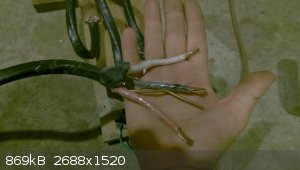 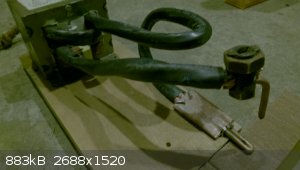 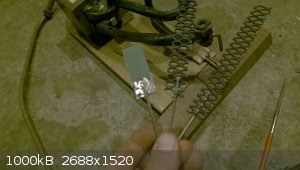 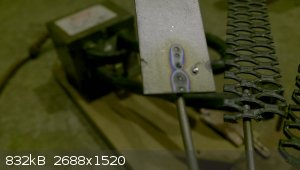 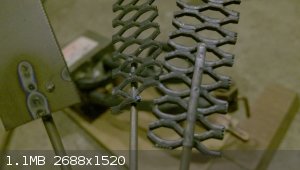
1)you can see the size wire I used for the 1-1/2 wrap
2) front of the transformer
3) tacks on plate and two mesh MMO pieces
4) close up of the spots
5) another close up
they seem physically OK, not super strong, but short of TRYING to tear them off the Ti wire wasn't going any where. survived 3 increasing tweaks with
out snapping. how they perform chemically is another thing. I only flattened out an edge on one of the wires, which mean the other two have less
surface area meeting, which was also really hot in standard atmosphere ( no O2/N2 shield of any kind used ) so it may make a nifty lill cave for gas
generation from weakened titanium, may be fine.
on my first try with two wire pieces, it got hot, then blew out. after cooling it looked like the heart of the two wires shot out through two
volcanic craters ( tiny ones, but half the depth of the wire)
fun learning experience, now it's time to make a sweet lever arm to reliably spotweld. .... and figure out how to bend the Ti plate at a
90'<, every time I do it snaps just prior to 90'. but I wanted to make support strips similar to what is seen in a pool electrode stack. because
I am actually trying to use this for my pool.
-Violet Sin-
|
|
|
hyfalcon
International Hazard
    
Posts: 1003
Registered: 29-3-2012
Member Is Offline
Mood: No Mood
|
|
You need expanded mesh titanium. It takes to being bent better than solid sheet. I've gotten right at 330 degrees without it breaking.
Superscripts don't seem to be working.
Little Ghost, Look at his MMO mesh. You should be getting 2 pieces
of the same size in the Post shortly.
[Edited on 11-10-2014 by hyfalcon]
[Edited on 11-10-2014 by hyfalcon]
|
|
|
violet sin
International Hazard
    
Posts: 1475
Registered: 2-9-2012
Location: Daydreaming of uraninite...
Member Is Offline
Mood: Good
|
|
I had looked for the bare titanium mesh, but couldn't find any in my price range for this project. probably would have had a hard time ordering such
a small amount as well.
what I ended up getting 2 @ 6.75" x 10" MMO mesh from laserred, and 8 @ 3.125" x 8" x 1/16th plate from ebay. I also have a dwindling supply of ~3mm
wire welder Ti purchased a few years back( soo many electrodes were made). the metal is a bit tough on tools, I'm not set up with a metal working
shop. that was immediately apparent. I purchased more than I need, so several attempts could be made. some of the plate is to be cut up for
support of the small stack that will be built.
but I am quite pleased with the spotwelder capability, and have already cut and drilled two steel pieces for the electrodes as support plates for the
copper so I can apply some force with a lever. it gets hot quick and increased force will allow for a stronger bond with less discoloration, from
what I am seeing. as it is, I was using multiple quick 1-2 sec heating. at least the oxidation stayed localized. also noted, after messing around
with it for 20 min off and on accessing its capabilities, it( the secondary) was only slightly warm and the core was still cold to the touch.
|
|
|
papaya
National Hazard
   
Posts: 615
Registered: 4-4-2013
Member Is Offline
Mood: reactive
|
|
A question about "standard" MMO pool chlorinating anode - recently I got some from very well know *bay seller, but what I got raises few questions to
me.
first - it has some rust-colored spots on the surface, also it's not completely dark and has even golden-copper red tint on some sites - is this
normal or the anode is already hard-used?
second - I tested it in a NaCL solution at LOW current densities (about 0.5A on 5cm2 and 3.9V) - surprisingly after some time it still
works(electrolyzing), but now I have some orange stuff floating on the surface of water, and since the cathode is made of high quality titanium - it
comes from MMO anode. I changed the solution with a fresh one - and once again after few hours of electrolysis some orange-brown stuff is floating on
top! Is this anode wearing out or what? I thought MMO is really rough stuff, what is going on???
|
|
|
Metacelsus
International Hazard
    
Posts: 2531
Registered: 26-12-2012
Location: Boston, MA
Member Is Offline
Mood: Double, double, toil and trouble
|
|
Sounds like iron(iii) oxide. Are you sure the MMO substrate is Ti for your anode? I would suggest testing your crud for iron.
|
|
|
papaya
National Hazard
   
Posts: 615
Registered: 4-4-2013
Member Is Offline
Mood: reactive
|
|
The substrate stays unaffected since I can see from sides (where it was cut) - most likely it's titanium, magnet doesn't act on it. So far I don't see
any major damage also to coating, but that brownish crap collecting on the top makes me think it's degrading!
Coating must be RuO2 based, not something like Co oxide, isn't it? In the past I was experimenting with self-made Ti/Co3O4 anodes, which were not very
stable and were degrading like this (if it's really degrading)one giving out floating stuff, is it possible that I got Co3O4 anodes instead of
RuO2(do they exist in the market?)?
I just really want to listen to everybody who worked with MMO what they think on this issue, please..
|
|
|
papaya
National Hazard
   
Posts: 615
Registered: 4-4-2013
Member Is Offline
Mood: reactive
|
|
After 12 hours of electrolysis there was not only orange junk floating on top, but also some white fluffy stuff floating in the liquid. Sh*t! After
that I started with a fresh NaCL solution third time and already after half hours there's that same orange thing appearing! Of course I don't use
distilled water as a solvent - just plain water and table salt, but this cannot be the problem, isn't it? Somebody say something, I'm quite
disappointed.
|
|
|
| Pages:
1
..
42
43
44
45
46
..
48 |